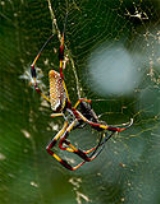
Golden silk orb-weaver
Overview
Genus
In biology, a genus is a low-level taxonomic rank used in the biological classification of living and fossil organisms, which is an example of definition by genus and differentia...
of araneomorph spider
Spider
Spiders are air-breathing arthropods that have eight legs, and chelicerae with fangs that inject venom. They are the largest order of arachnids and rank seventh in total species diversity among all other groups of organisms...
s noted for the impressive webs they weave. Nephila consists of numerous individual species found around the world. They are also commonly called golden orb-weavers, giant wood spiders, or banana spiders. In North America
North America
North America is a continent wholly within the Northern Hemisphere and almost wholly within the Western Hemisphere. It is also considered a northern subcontinent of the Americas...
, the golden silk orb-weavers (see also Nephila clavipes
Nephila clavipes
Nephila clavipes is a species of golden orb-web spider. It lives in the warmer regions of the Americas. The large size and bright colours of the species make it distinctive...
) are sometimes referred to as writing spiders due to occasional zigzag patterns (stabilimenta) built into their webs, though these occur much more frequently in the webs of Argiope
Argiope (spider)
The genus Argiope includes rather large and spectacular spiders that have often a strikingly coloured abdomen. These are well distributed throughout the world, and most countries in temperate or warmer climates have one or more species, which look similar....
, such as the St Andrew's Cross spider.
The species N. jurassica
Nephila jurassica
Nephila jurassica is an extinct species of spider in the family Nephilidae, which contains the golden silk orb-weavers. The species is known only from the Middle Jurassic Jiulongshan Formation, part of the Daohugou Beds, near the village of Daohugou in Ningcheng County, northeastern China.-History...
, which lived about 165 million years ago, had a leg span of some 15 cm, and is the largest known fossilized spider.
The genus name Nephila is derived from Ancient Greek
Ancient Greek
Ancient Greek is the stage of the Greek language in the periods spanning the times c. 9th–6th centuries BC, , c. 5th–4th centuries BC , and the c. 3rd century BC – 6th century AD of ancient Greece and the ancient world; being predated in the 2nd millennium BC by Mycenaean Greek...
, meaning "fond of spinning", from the words (nen) = to spin (related to nema νήμα "thread") + φίλος (philos) = "love".
Nephila spiders vary from reddish to greenish yellow in color with distinctive whiteness on the cephalothorax and the beginning of the abdomen.

